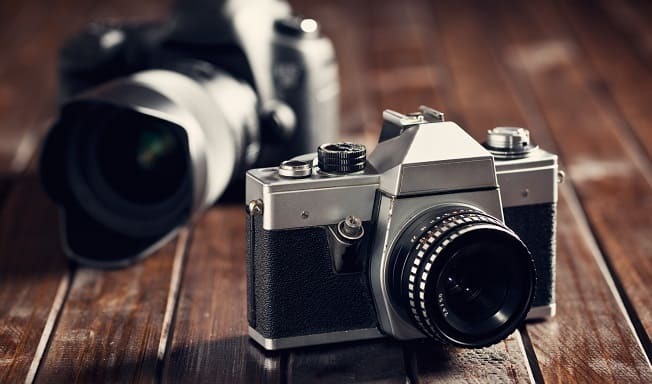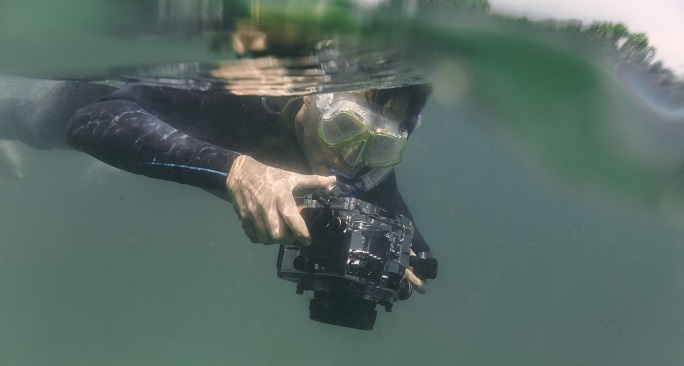
 Data Structure
Data Structure Networking
Networking RDBMS
RDBMS Operating System
Operating System Java
Java MS Excel
MS Excel iOS
iOS HTML
HTML CSS
CSS Android
Android Python
Python C Programming
C Programming C++
C++ C#
C# MongoDB
MongoDB MySQL
MySQL Javascript
Javascript PHP
PHP
- Selected Reading
- UPSC IAS Exams Notes
- Developer's Best Practices
- Questions and Answers
- Effective Resume Writing
- HR Interview Questions
- Computer Glossary
- Who is Who
What is the full form of DSLR?
Introduction
Digital Single-Lens Reflex (DSLR) camera uses a mirror and prism system, which enables the photographer to see the picture via the camera's lens. This method allows the photographer to see exactly what the lens sees by reflecting the light going through the lens onto the camera's optical viewfinder.

The mirror opens when the shutter button is depressed, allowing the image sensor of the camera to record the scene and turn the light into a digital image. Professional photographers and serious amateurs alike prefer DSLR cameras because of their great image quality, adaptability, and lens-changing capabilities.
Components of DSLR
The main components of a Digital Single-Lens Reflex (DSLR) camera are
Lens A DSLR camera's lens is an essential part that lets light into the device and concentrates it on the picture sensor. DSLR cameras frequently contain interchangeable lenses, allowing photographers to modify their focal lengths or optical properties by switching out their lenses.
Mirror The viewfinder is illuminated by the light entering the lens and reflecting off the mirror. The mirror flips up when the shutter button is depressed, allowing light to enter the image sensor.
Prism The prism allows the photographer to see what the lens sees by reflecting light from the mirror into the viewfinder.
Image Sensor The image sensor is an electrical component that creates a digital image from the light that was caught by the lens. The final image's quality can be significantly influenced by the image sensor's quality.
Shutter The shutter manages how long the picture sensor is exposed to light for. The shutter opens when the shutter button is depressed, enabling light to enter the image sensor, and then shuts again after a certain period of time.
Mode Dial The mode dial on the camera is a control that lets the photographer choose the shooting mode they wish to employ, such as manual mode, aperture priority, or shutter priority.
Control Buttons DSLR cameras typically have a range of buttons and controls that allow the photographer to adjust settings such as shutter speed, aperture, and ISO.
LCD Display The LCD screen on the camera's rear lets the user study and preview photos, navigate the menu system, and change settings.
Advantages of DSLR
Using a Digital Single-Lens Reflex (DSLR) camera has a number of advantages, such as
Image Quality DSLR cameras may capture more detail and generate photographs of a better caliber since they often have bigger image sensors and greater resolution than other types of digital cameras.
Manual Controls DSLR cameras provide a variety of manual options for changing parameters including ISO, shutter speed, and aperture. Photographers can now have more creative freedom over their photographs because of this increased control.
Viewfinder An optical viewfinder on a DSLR camera shows what the lens sees in a clear and precise manner, making it simpler to frame and focus the photo.
Durability DSLR cameras often have weather-sealed bodies that can survive extreme circumstances, making them more robust than other types of digital cameras.
Versatility Landscape, portrait, sports, and wildlife photography are just a few of the many types of photography that can be done with a DSLR camera.
Professional photographers and serious enthusiasts alike like DSLR cameras because they provide excellent image quality, adaptability, and a number of cutting-edge features and settings.
Disadvantages of DSLR
While using a Digital Single-Lens Reflex (DSLR) camera has many benefits, there are some disadvantages that should be considered including
Size and Weight DSLR cameras tend to be bigger and heavier than other kinds of digital cameras, which may make them more cumbersome to carry around, especially when travelling or using them for lengthy periods of time.
Cost When you take into account the price of lenses and accessories, DSLR cameras are often more expensive than other types of digital cameras.
Complexity Compared to other types of digital cameras, DSLR cameras can be more challenging to use and have a high learning curve. For individuals who are just starting out or are unfamiliar with the technical side of photography, this may be intimidating.

Noise When taking a picture, a DSLR camera's mirror mechanism can make noise and vibrate, which can be distracting or disruptive, especially in quiet settings.
Limited Video Features Despite being able to record high-quality video, DSLR cameras sometimes offer fewer video functions than specialist video cameras, such as a limited range of focusing and audio options.
Sensor Cleaning In order to eliminate dust and other debris that might build up on the image sensor, DSLR cameras occasionally need to have their sensors cleaned. This process can be time-consuming and may call for a professional cleaner.
DSLR cameras are a wonderful option for photographers who need excellent image quality, adaptability, and sophisticated features and settings, but because of their size, complexity, and price, they might not be the ideal option for everyone.
Conclusion
Due to excellent image quality, adaptability, and lens-exchangeability, DSLR cameras are preferred by both serious amateurs and professional photographers. In addition to manual controls for shutter speed, aperture, and ISO, they provide a broad range of settings and shooting modes, including program, aperture priority, and shutter priority. DSLR cameras are a popular choice for videographers as well since they can capture high-quality video. However, compared to other digital camera types, they frequently have a larger and heavier design, which can make them less practical for everyday use or travel.
FAQs
Q1. What types of photography are DSLR cameras good for?
Ans: DSLR cameras are adaptable and may be utilised for a variety of photographic genres and styles, from sports and wildlife photography to landscapes and portraiture.
Q2. How can I clean the picture sensor on my DSLR camera?
Ans: You may use a sensor cleaning kit, which comes with a specific swab and cleaning solution, to clean the image sensor on your DSLR camera. As an alternative, you may get the sensor cleaned on your camera by taking it to a reputable camera shop or servicing facility.
Q3. Do I need to be a professional photographer to use a DSLR camera?
Ans: No, a DSLR camera can be used by anyone, regardless of their degree of experience. However, learning how to use the manual controls and settings on DSLR cameras can be challenging and may take some practice.

